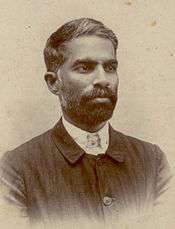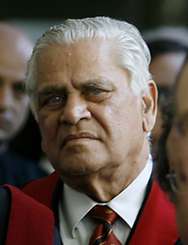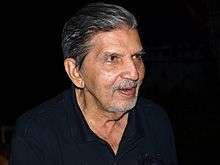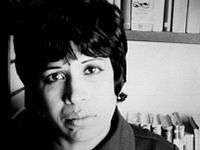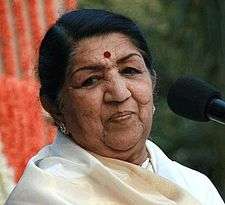Goans
| |||||||||||||
| Regions with significant populations | |||||||||||||
|---|---|---|---|---|---|---|---|---|---|---|---|---|---|
| Outside Republic of India | ~300,000[1] | ||||||||||||
| Languages | |||||||||||||
|
Primarily: Konkani Additionally: English, Portuguese, Marathi, Swahili and others | |||||||||||||
| Religion | |||||||||||||
|
Predominantly: Hinduism and Christianity(Roman Catholicism) Minority: Islam and others | |||||||||||||
Goans (Konkani: गोंयकार, Romi lipi: Goenkar, Portuguese: Goeses) is the demonym used to describe the people of Goa, India, who form an ethno-linguistic group resulting from the assimilation of Indo-Aryan, Dravidian, Indo-Portuguese and Austro-Asiatic ethnic and/or linguistic ancestries.[2][3] They speak different dialects of Konkani natively. Goan Hindus refer to themselves as Konkane (Devanagari: कोंकणे), meaning the residents of an area broadly identified as Konkan.[4] Goanese is an incorrect usage for Goans.[5]
Epigraphical evidence
A copperplate dating to the early 4th century found in Shiroda, mentions one Devaraja of the Gominas, which is a reference to the Bhoja king ruling from Chandor, who is hailed as the ruler of the Goans or Gominas.[6]
Language
Goans mainly speak the Konkani language, a Prakrit based language belonging to the Southern group of Indo-Aryan Languages. Various dialects of Konkani spoken by the Goans include Bardeskari, Sashtikari, Pednekari, Antruj bhasha, whereas Konkani spoken by the Catholics is notably different from those of the Hindus, with a lot of Portuguese influence in its vocabulary. Konkani was suppressed for official documentation use only not for unofficial use under the Portuguese governance, playing a minor part in education of the past generations. They are mostly multilingual and Marathi has played a significant role for Hindus near the borders of Goa close to Maharashtra and parts of Nova Goa conquest.
They use Devanagari and Latin script for education as well as communication (personal, formal and religious). In the past Goykanadi, Modi, Kannada scripts were also used which later fell into disuse owing to many social, political and religious reasons.[7][8]
Religion
Goans are predominantly Hindus followed by Roman Catholics and a small Muslim community. Hindus in Goa are divided into many different castes and sub-castes, known as Jatis. They use their village names to identify their clans, some of them use titles. Some are known by the occupation their ancestors have been practicing; Nayak, Borkar, Raikar, Prabhu, Kamat, Lotlikar, Chodankar, Mandrekar, Naik, Bhat, Tari, Gaude are examples.
The Catholics display Portuguese influence in the form of a hierarchy due to being for 451 years, a Portuguese Empire overseas province. Portuguese names are common among the Christians. The Caste system is followed to a lesser degree as compared to other Indians mainly of peasant class.[9] However, there is a distinct Roman Catholic Brahmin community in Goa that is mainly endogamous. Many Catholic families also share Indo-Portuguese ancestry.
The native Muslims are small in number and are popularly known as Moir although Muhamedan was the word used in Portuguese to identify them, they are descendants of Mughals and Arab tradesmen. (Konkani: मैर ).[9]
Geographical distribution
Goans have been migrating all along the coast and across the world for the last six centuries because of socio-religious and economic reasons. The diaspora are commonly known as the Konkani people, residing in the states of Karnataka, Maharashtra and Kerala, and do not refer to themselves as Goans. Many Goans have settled in Mumbai (Bombay) in the last century and still identify themselves as Goans. Besides Mumbai, India's Goan population is mainly concentrated in the major cities like Bangalore, Kolkata, Delhi, Chennai and Pune.[10]
Until the early 1970s there were substantial populations of Goans in the Middle East, Africa and Europe. There have also, historically, been Goans in former British colonies of Kenya, Uganda, and Tanzania, and Portuguese colonies of Mozambique and Angola. The end of colonial rule and the subsequent waves of expulsion of Indians from Kenya and Uganda forced the community to migrate elsewhere, however.[10] The Gulf News put the number of Goans residing outside India as approximately 300,000.[1]
See also
- Goan Catholics
- Goan Hindus
- Caste system in Goa
- Goan cuisine
- Konkani people
- List of people from Goa
- Goan houses
- Luso-Asians
- Eurasian (mixed ancestry)
References
| Look up Goan in Wiktionary, the free dictionary. |
- 1 2 "Young NRIs trace their roots in Goa". Gulf News. December 8, 2008. Retrieved 2008-12-21.
- ↑ Pereira, José (2000). Song of Goa: mandos of yearning. Aryan Books International. pp. 234 pages. ISBN 9788173051661.
- ↑ Cabral e Sá, Mário (1997). Wind of fire: the music and musicians of Goa. Promilla & Co. pp. 373 pages(see page 62). ISBN 9788185002194.
- ↑ Kulakarṇī, Indian Council of Historical Research, A. Rā (2006). Explorations in the Deccan history Volume 9 of Monograph series. Pragati Publications in association with Indian Council of Historical Research. pp. 217 pages(see page 129). ISBN 9788173071089.
- ↑ Pinto, Cecil (2003-11-07). "Goanese & non-Goans". Goa Today magazine. Goa Publications. Retrieved 2008-07-04.
- ↑ De Souza, Teotonio R. (1990). Goa Through the Ages: An economic history, Volume 2. Concept Publishing Company. p. 8. ISBN 9788170222590.
- ↑ Indian archives. Volume 34. National Archives of India. National Archives of India. p. 1985.
- ↑ Kamat, Krishnanand Kamat. "The origin and development of Konkani language". www.kamat.com. Retrieved 31 August 2011.
- 1 2 Śiroḍakara, Mandal,, Pra. Pā,H. K. ,Anthropological Survey of India. People of India: Goa Volume 21 of People of India, Kumar Suresh Singh Volume 21 of State Series, Kumar Suresh Singh. 1993: Anthropological Survey of India. pp. 283 pages. ISBN 9788171547609.
- 1 2 De Souza, Teotonio R. (1989). Essays in Goan history. Concept Publishing Company. pp. 219 pages(see pages 187–190). ISBN 9788170222637.
| ||||||||||||||||||||||||||||||||||||||||||||||||||||||||||||||
| ||||||||||||||||||||||||||||||||||||||||||||||||||||||||||||||||||||
